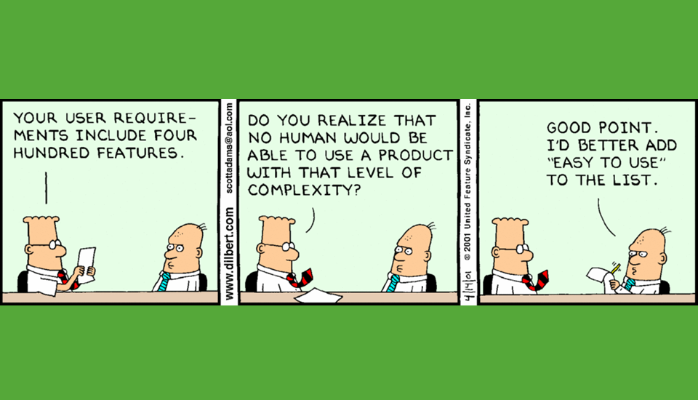Editor's Note: Take a look at our featured best practice, Non Functional Requirements (NFR) Example Sets (Excel workbook). Requirements for IT systems are often divided into two broad categories: Functional Requirements and Non-functional Requirements. Functional Requirements are usually focused on describing the ICT functionality most visible to users. Non?functional requirements are equally important but often less [read more]
* * * *
 Requirements gathering is a small phase of the project. Why do we need a plan for it?
Requirements gathering is a small phase of the project. Why do we need a plan for it?
We have a project management plan for the project. Why do we need one more plan?
We follow agile life cycle where in the project cycle is shortened. Then, why is requirements management plan needed?
Given below is an indicative list of items/aspects that are managed in Requirements management plan.
- Overview of the project – Describing the overview and objectives of the project
- Terms and Glossary – Terms, abbreviations and definitions specific to the project used in the document can be described here
- Infrastructure – Hardware, software, tools needed for the project
- Communication plan/mechanism – what will be the communication mechanism, frequency and audience /stakeholders
- Structure – Which part of the requirements will be contained in which document e.g. SRS will contain use case description, BRD will contain the business requirements
- Traceability Guidelines – How the requirements will be traced e.g. project objectives à stakeholder request àBRDàSRS
- Prioritization Guideline – How the requirements will be prioritized e.g. statutory/legal requirement, Critical business objective then it will be high priority
- Techniques – what techniques will be used in which situation, from the usual techniques like SWOT, Matrix model, surveys and techniques etc
- Change Management – How will requirements change be handled, the requirements change management process can be documented here
- Change control board – the constitution and the authority of the board can be described here e.g. functional requirements <20 Hrs can be authored by Requirements analyst, reviewer can be Lead BA and Domain SME, approver can be PM
- CM Plan – who will be owner for which document like Flow diagrams, prototypes
- Metrics – Typical metrics can be % of requirements delivered as per requirements management plan, Average effort spent per detailed requirements document, Number of defects identified per use case
- Attributes – Attributes of the requirement can be detailed here will need to contain the attribute name, description, type, Values
- System context – Various system context such as stakeholders, interfacing systems etc
- Sources and techniques – This will detail out the type of requirements, Source of the requirement, techniques for Elicitation and Modelling
- Stakeholder Matrix – This will have details of the various stakeholders like name, type, role, Criticality, expectations, contact details etc
- Resource structure of the BA/RE team with name, role, contact details etc
- Skill gap analysis and Competencies needed
- Effort estimate for the Requirements engineering task
- RACI Matrix for the various types of requirements
- Risks and assumptions – Risks and Assumptions for the requirements of the project with impact, mitigation plan
- Activity plan – Activity/ task plan with schedule, responsibility, effort needed, deliverable details
- RMP checklist – To ensure all the planned activities and tasks are completed
A requirements management plan is needed as much as a project plan is needed for a project and smooth functioning of the project.
Please see a video demonstration of the template here.

Excel workbook
Software requirements management plan content:
Competencies needed
Infrastructure
Communication plan
Structure
Traceability guidelines
Priorization guidelines
Techniques selection guidelines
Change management guidelines
Change control board
Config management
Metrics
Requirements
[read more]
Do You Want to Implement Business Best Practices?
You can download in-depth presentations on Requirements Gathering and 100s of management topics from the FlevyPro Library. FlevyPro is trusted and utilized by 1000s of management consultants and corporate executives.
For even more best practices available on Flevy, have a look at our top 100 lists:
These best practices are of the same as those leveraged by top-tier management consulting firms, like McKinsey, BCG, Bain, and Accenture. Improve the growth and efficiency of your organization by utilizing these best practice frameworks, templates, and tools. Most were developed by seasoned executives and consultants with over 20+ years of experience.
Readers of This Article Are Interested in These Resources

Excel workbook
The Requirements Traceability Matrix (RTM) is an excel spreadsheet that links the product requirements to design and test cases. The purpose of a RTM is to provide a means to trace requirements throughout the project lifecycle. It also ensure that all requirements are tested and validated.
[read more]

Excel workbook
Adaptive\'s Business requirements template to capture:
HLL Requirements
General Features
Context diagram
NFR Checklist
Implicit Requirements
Requirements Catalog
Out of scope
Environment (Platform / Technology Requirements)
Data migration / retention / volume
Navigation
[read more]

38-slide PowerPoint presentation
This is a comprehensive training resource for Agile practitioners and teams looking to master the art of product backlog management and prioritization. With a focus on enhancing Agile project management skills, this deck covers various key topics:
Product Backlog Overview: Understand the
[read more]

13-slide PowerPoint presentation
In this PowerPoint, you will understand How the is User Requirement Approach by using User-Centered Design (UCD) as It is a product development approach focuses on the end-users of a product.
By collecting user requirements, Testing Prototyping, and design the user profiles, Persona & the
[read more]
 Requirements gathering is a small phase of the project. Why do we need a plan for it?
Requirements gathering is a small phase of the project. Why do we need a plan for it?



